Government job openings plunged 23% year-over-year. Federal government hires plunged 33% year-over-year.
By Wolf Richter for WOLF STREET.
The red-hot turnover in the labor market has settled down from the chaos and churn in 2021 and 2022. The labor market has been loosening from the extremely tight levels of the labor shortages. Companies have been careful with their layoffs and discharges, and they remain low. Workers have quit quitting. Job openings and hiring have declined because fewer quitters leave fewer job openings behind that need to be filled. But federal and state government hires and job openings have plunged as government payrolls have gone on a diet this year. This is what we’re seeing in the Job Openings and Labor Market Turnover Survey (JOLTS) of 21,000 work sites, released today by the Bureau of Labor Statistics.
In addition, as we can see from the nonfarm jobs report earlier in September, companies have been adding new jobs at a much slower pace than in prior years, though they’re still adding jobs, but state and federal governments have been shedding jobs in large numbers.
In addition, but not directly visible here, the crackdown on illegal immigration is starting to constrain the supply of labor, which is a good thing for workers at the lower end of the pay scales.
Job openings in August rose by 19,000 to 7.23 million, and July was revised higher (blue in the chart). All data here is seasonally adjusted.
The three-month average, which irons out the month-to-month squiggles, declined to 7.26 million openings (red). For over a year, they’ve been near the pre-pandemic highs in late 2018 and early 2019, but have come down a lot from the era of the labor shortages.
Government job openings (federal, state, and local) plunged by 23% year-over-year, while private sector job openings dipped by 2.6%.
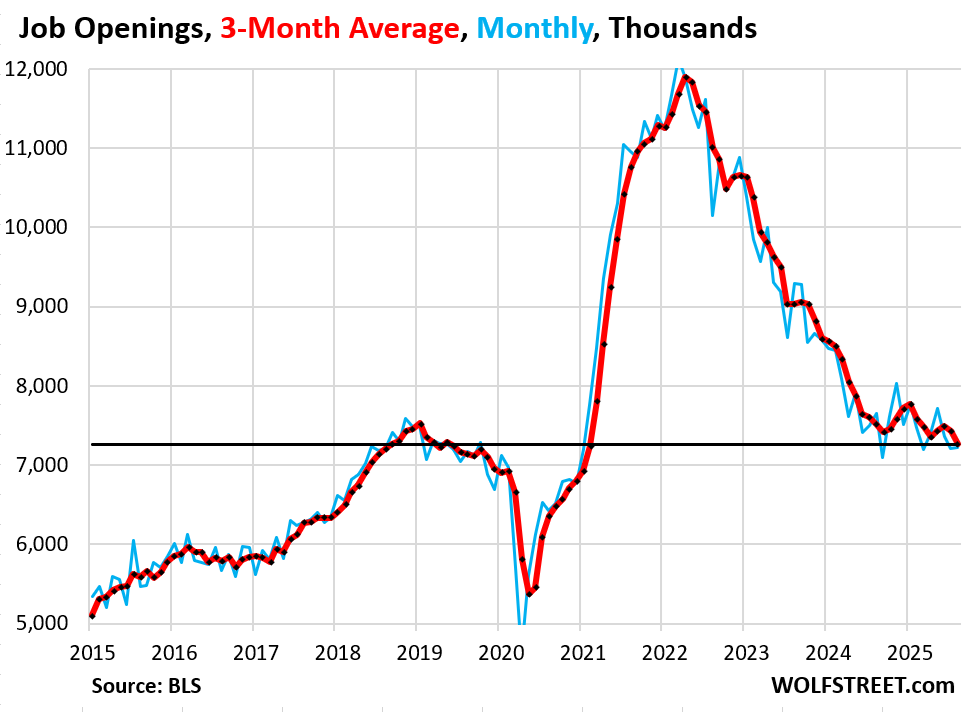
Job openings are mostly a result of quits, layoffs and discharges, and other separations (retirements, deaths while employed, etc.). Only a small portion of these 7.5 million openings represent newly created jobs.
Churn in the labor market – how many workers quit voluntarily to work somewhere else, how many were discharged for whatever reason, how many retired or died, and how many were hired to fill these left-behind job openings – had exploded in 2021 and 2022.
Labor market churn of this magnitude was expensive and inefficient, but it ended up reshuffling where people worked, producing better matches between workers’ skillsets and aspirations and companies’ needs, which would be a positive outcome.
Quits fell by 75,000 in August from July to 3.09 million workers who quit their jobs voluntarily, such as to take a better job somewhere else. They do not include retirements, deaths, etc. (blue in the chart).
The three-month average quits declined by 76,000 to 2.97 million quits (red in the chart). The low point in quits was in late 2024.
Fewer quits means fewer job openings left behind, and less hiring to fill those newly left behind job openings.
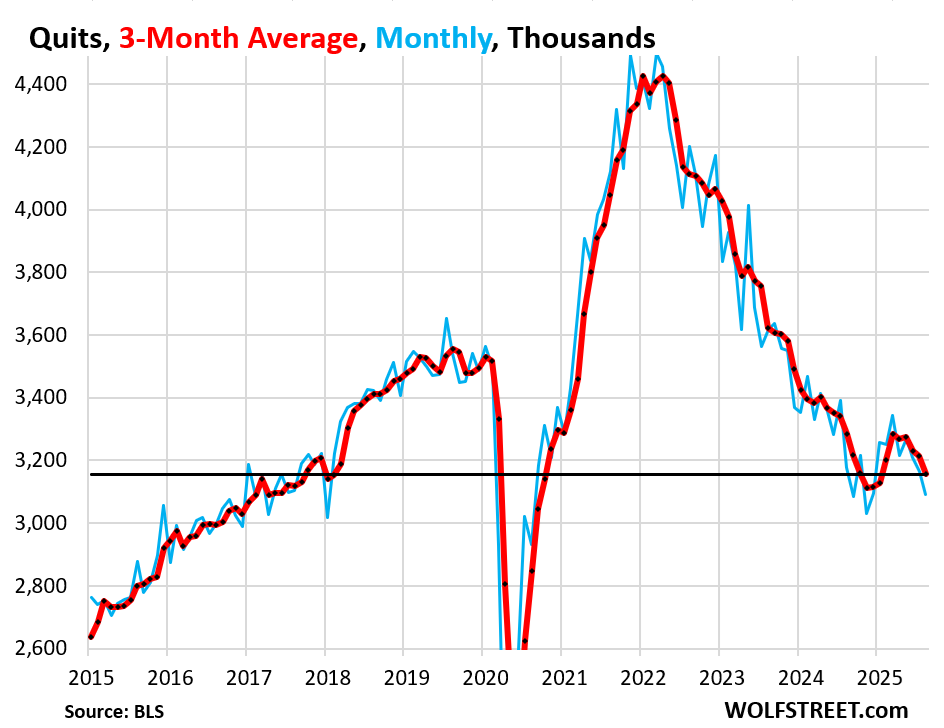
Layoffs and discharges fell by 62,000 in August from July, to 1.72 million. The three-month average rose to 1.77 million. The high point was in late 2024.
After rising from the record lows during the labor shortages, layoffs and discharges have been at the low end of the range before the pandemic. This confirms other data, including unemployment insurance claims, that show that companies are keeping layoffs and discharges low.
Low layoffs and discharges mean fewer job openings, and less hiring.
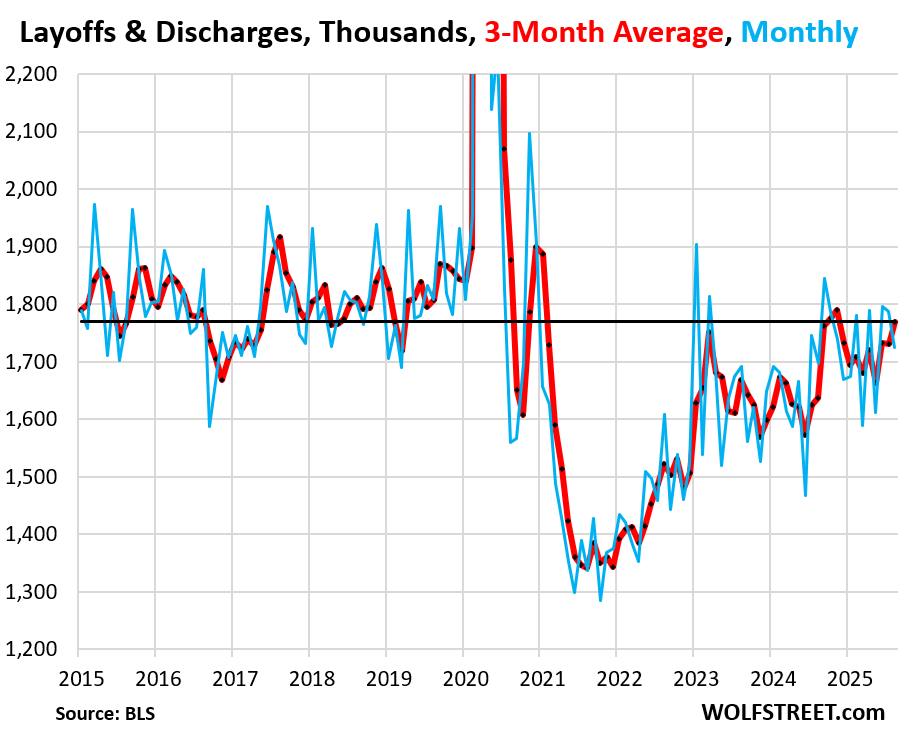
Other separations (retirements, deaths while employed, etc.) totaled 295,000 in August.
They’re a small factor, compared to layoffs and discharges of 1.72 million and quits of 3.09 million. And they’re largely unrelated to the economy and not reactive to recessions.
But we can see two large waves of retirements: One started in early 2021 when people chose to retire rather than return to work, and the other started in mid-2023. We can also see a mini-surge earlier this year, likely due to retirements at federal and state governments as part of their job reductions.
Because the monthly figures are so small with relatively huge spikes and plunges from one month to the next, we’re looking at the six-month average here:
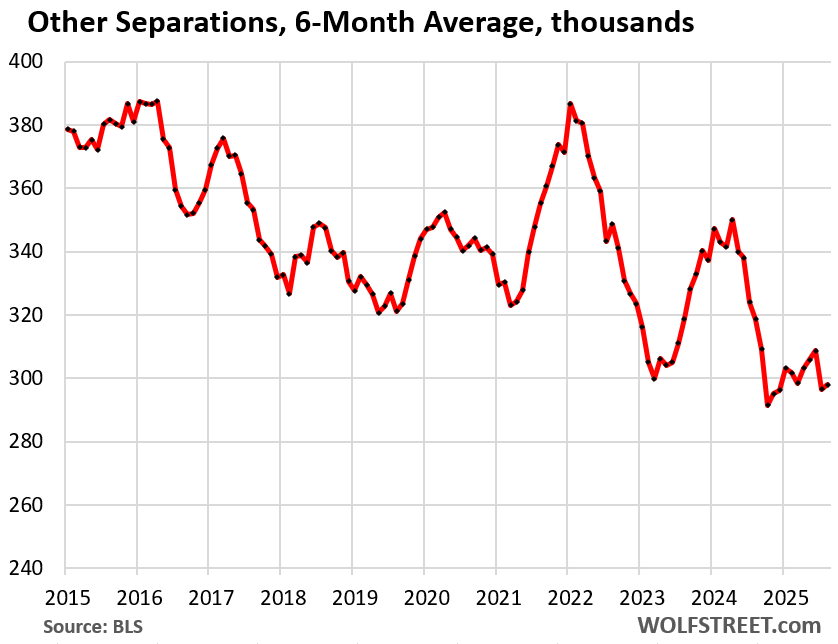
Hires declined by 114,000 in August from July, to 5.13 million. The three-month average declined by 113,000, to 5.21 million hires, after the spurt of hiring earlier this year.
Year-over-year, the three-month average hires dipped by 0.9%. But hires by the federal government plunged by 33%.
Most of these 5.13 million hires in August replaced workers who’d quit their jobs, or who were discharged or laid off for whatever reasons, and who’d retired or died.
Only a small portion were hired to fill newly created jobs. The jobs report for August, released earlier this month, showed that employers added 22,000 nonfarm payroll jobs in August, and July was revised up to 79,000 jobs added on net.
The low number of quits and the low number of layoffs and discharges mean that companies need to hire fewer people to fill the job openings left behind.
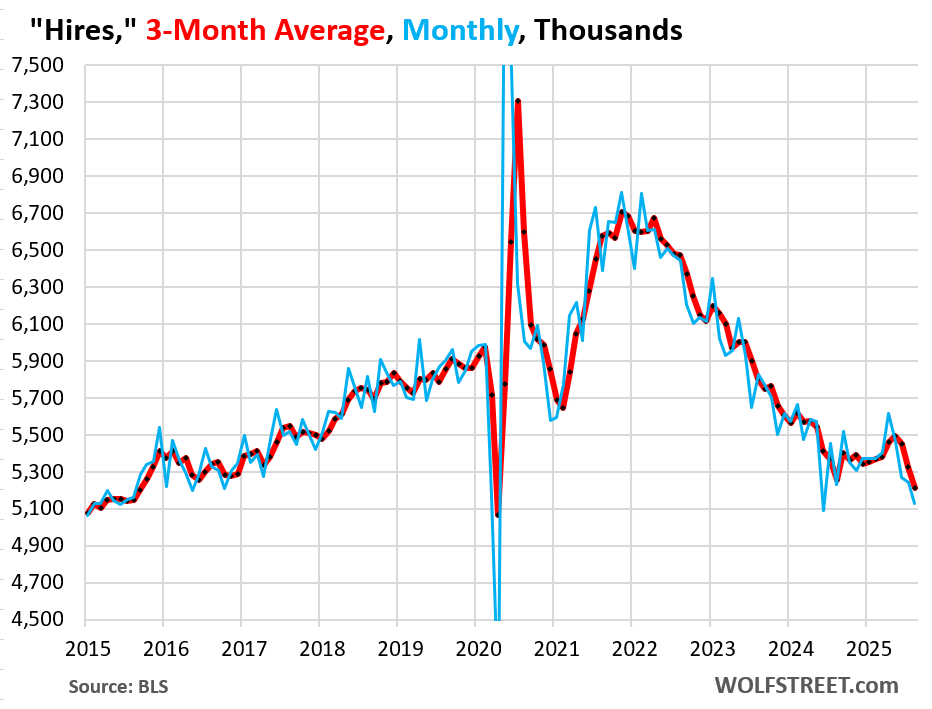
Enjoy reading WOLF STREET and want to support it? You can donate. I appreciate it immensely. Click on the mug to find out how:
![]()


Be interesting what the Fed does if a government shutdown happens. I assume they wouldn’t get their regular numbers from BLS for decision making around interest rates but perhaps that wheel keeps churning.
Wall Street largely thinks that no data means they assume the economy is still on the same (weakening) trajectory = lower rates.
FOMC meeting is at the end of October so there’s time. It’s not likely the shutdown lasts the entire month.
Nothing will change. This is not a matter that concerns the Federal Reserve.
In the Grand Rapids to Muskegon Michigan job market, the construction market has been steady, with few reductions in staff other than poor performance which has seen low terminations. Although it seems right now that construction has peaked. New demands for labor are considerably lower. The service industry employment is steady with average hours on the higher side. Many companies are using stronger sales methods and lower cost specials. My personal thought from conversations is that next year we are going to see a slow down. And layoffs will gain in numbers.
Construction down over 100k in the release.
It’s “no hablo inglés”
After a big spike over the prior two months to the highest since May. Month-to-month “squiggles.”
The “big spike” was less than this months drop and total openings are at a new local low.
Here are the actual jobs in construction (as illegal labor is getting scared off or hauled off, such as at the Hyundai plant). The job openings represent the jobs that haven’t been filled yet. Obviously, if you paid attention, you know that housing construction has slowed some.
So what is the best policy response to unfreeze the labor market? The only thing monetary easing would accomplish is more (speculative) asset price inflation, not more jobs.
A lot of employers are using AI and “regulatory uncertainty” esp. around tariffs & immigration as their official justification for low hiring rates or even layoffs when speaking to the press.
Next year is a midterm election year, so policy should be more stable. If the job market doesn’t rebound by then, what excuse will employers give?
The labor market isn’t frozen and doesn’t need to “unfreeze.” The housing market is “frozen” though.
By “frozen” I mean the current low-hire low-fire market, which certain policymakers are extremely concerned about even as the broader economy holds up.
How do we get from low-hire low-fire back to an environment with abundant hiring.
“How do we get from low-hire low-fire back to an environment with abundant hiring.”
More people need to quit their jobs. That’s how millions of job openings are created every month, 3 million job openings were created in August by people who quit their jobs and left a job opening behind. It’s the biggest factor in creating job openings. But workers quit quitting. This is like the main topic of the article.
The unemployment rate is near all time lows. The labor force participation for 25-54 is near all time highs.
For 20-24 year olds, it is around 70, which is what it has been near since 2008.
The reason for slow hiring is because employers don’t need anymore workers because they are full.
These charts look pretty tame and normal compared to house sales. The US is going to hit population equilibrium much faster than previously estimated. You better get used to it.
The best policy response is to f off but if there’s one thing they won’t do it’s that.
@Anon, spot on. So many of my solo practitioner colleagues, myself included, retired earlier than we wanted to because we got regulated into oblivion. With less competition in our fields, the new young docs that tolerate these regs don’t need to participate in-network with insurance companies and can now charge whatever they want making the care less affordable for the public. Government regulations exemplify the “law of unintended consequences” as immutable. “The road to hell is paved with good intentions” (and government regulations).
Wolf, I had a comment up for a few hours, and then you deleted it. It’s your site, do what you want. But I think I hear a chicken. I guess you have to kow-tow to your advertisers and your political correct patrons.
It was a bad comment for a variety or reasons. Wrong too. And it attracted replies that accused you of racism, and they weren’t off the wall.
I’ll pick lettuce for $800 an hour. And it’s okay with me if the government subsidizes the lettuce grower so we still pay only $2 a head at the grocery.